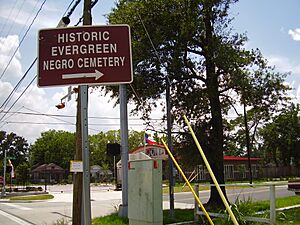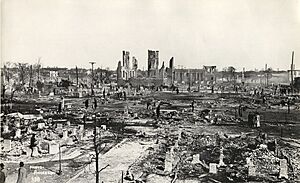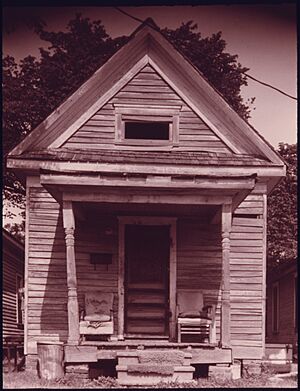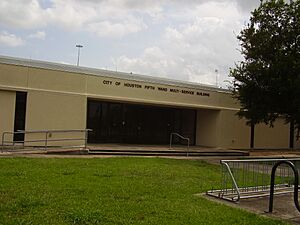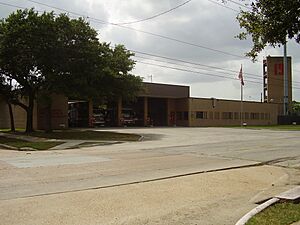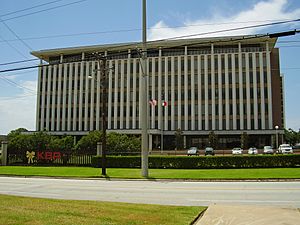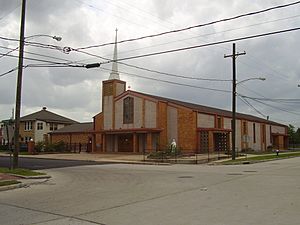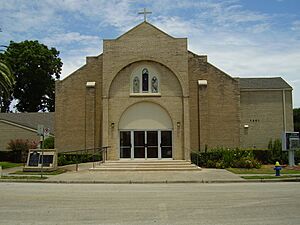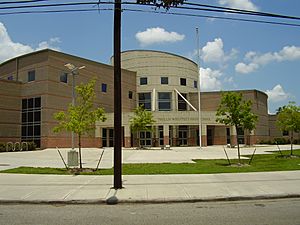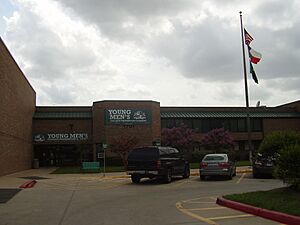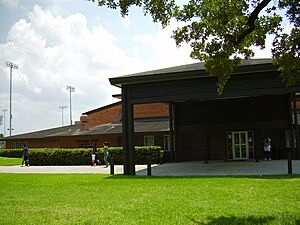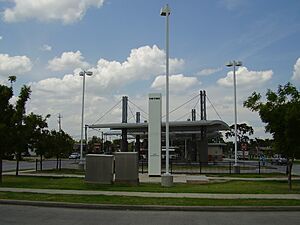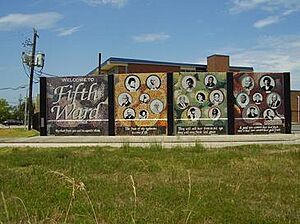Fifth Ward, Houston facts for kids
The Fifth Ward is a community in Houston, Texas, United States. It's about 2 miles (3.2 km) northeast of Downtown Houston. Its borders are Buffalo Bayou to the south, Jensen Drive to the west, Collingsworth Road to the north, and Lockwood Drive to the east.
The Fifth Ward is one of Houston's six historic wards. It was created from parts of the First Ward and Second Ward.
Contents
History
Early Days
When the Fifth Ward first started, many different groups of people lived there. A lot of residents were Irish and Jewish. The Jewish families had come from Russia and Eastern Europe to escape difficult times. The Irish families mostly lived in the northern parts of the ward. At first, the Fifth Ward was a successful area.
After the American Civil War, newly freed slaves began to settle in this less crowded area. In 1866, it officially became the Fifth Ward. An alderman (a type of city council member) from the ward was elected to Houston's City Council. By the mid-1880s, most residents were Black. They were working-class people who found jobs in Houston's industrial areas or as housekeepers for wealthy families. Mount Vernon United Methodist Church, started in 1865 by a former slave, is the oldest church in the ward. Five other churches are also over 100 years old. The "Island of Hope (Anderson Memorial Temple) COGIC" is also here, being the oldest Pentecostal church in the Fifth Ward. Over the years, it has been home to many different minority and immigrant groups. More Irish people, along with Germans and Italians, also settled in the Fifth Ward.
In the late 1800s, the Fifth Ward community twice considered leaving the city of Houston. This happened in 1875 and 1883. People complained about not having enough city services. This included fire and police services, street lights, trash collection, and drainage. The 1875 complaint asked for paved streets and better utility systems. The city government helped with the 1883 complaints by building a drawbridge at San Jacinto Street over the Buffalo Bayou. In the 1890s, parts of Odin Avenue (now Lyons Avenue) were paved with brick.
On February 21, 1912, a very strong fire started. It was the biggest fire in Houston's history and became known as the "Great Fifth Ward Fire." Strong winds helped the fire spread quickly. It burned a church, a school, 13 factories, eight stores, and 119 homes. Most of these were in the Fifth Ward. No one died, but the damage to property was over $3 million.
Mid-20th Century Changes
After World War I, more African Americans moved into the Fifth Ward. More families lived in each building to afford rent. This caused buildings to wear down. Some Jewish people stayed as landlords, but most moved away. Many went to New York City, including The Bronx and Long Island.
Before schools and public places were desegregated (meaning Black and White people were separated), the Fifth Ward was home to African Americans of all jobs and income levels. The community was sometimes called the "bloody Fifth" because of some well-known violent events. However, the Fifth Ward in the 1940s was not as run-down as it was in the 1990s. In the 1930s, the Fifth Ward was known as "one of the proudest black neighborhoods" in the U.S. More than 40 Black-owned businesses were located along Lyons Avenue at that time.
After World War II, many Black migrants, especially from Louisiana and East Texas, settled in the Fifth Ward. Many of these migrants could not get high-paying jobs, so the community became known for poverty.
In 1949, a company called Brown & Root started buying land in the Fifth Ward for its main offices.
When Interstate 10 was built, it went right through the Fifth Ward, splitting the community.
Between 1964 and 1974, the city government added some small parks. They also paved streets and added gutters and curbs in the southern part of the Fifth Ward.
Later Years (1970s-Present)
When desegregation happened, many middle-class African Americans moved to the suburbs. By the 1970s, the Fifth Ward lost many people. Many houses were empty, and businesses were closed. There were also many empty lots with overgrown plants.
In 1979, the average income in the Fifth Ward was much lower than the city average. Fewer people had high school diplomas, and more people lived in poverty. By 1979, only a few Italian American families remained. Many Black families had moved from the Fifth Ward to other Houston neighborhoods like Kashmere Gardens and Sunnyside.
In 1979, about 90% of the Fifth Ward looked run-down and showed signs of poverty. However, there were still some middle-class areas that looked better. The Fifth Ward was more crowded than most Houston neighborhoods. Many city blocks did not have proper drainage systems.
Between 1990 and 2000, the Hispanic population in the Fifth Ward grew. It went from about 19% to 31% of the population. During the same time, the Black population in the Fifth Ward decreased.
In 2000, the average yearly income was $8,900. Most residents (62%) lived below the poverty line. Also, 9 out of 10 school-aged children qualified for free or reduced-price lunches. Many commercial streets had empty buildings and vacant lots.
Demographics
In 2015, the Greater Fifth Ward Super Neighborhood had 19,687 residents. About 48% were Black (not Hispanic), 46% were Hispanic, and 4% were White (not Hispanic). Small numbers were Asian or other groups. In 2000, there were 22,211 residents. At that time, 63% were Black (not Hispanic) and 35% were Hispanic.
In 1870, 16% of all African Americans in Houston lived in the Fifth Ward. By 1910, this number grew to 21%.
Government and Services
The Fifth Ward is part of City Council District B. The Houston Police Department Northeast Patrol Division serves the community. The Houston Fire Department operates Station 19 Fifth Ward.
The Harris Health System provides healthcare. The Ripley Health Center serves the area, and the main public hospital is Ben Taub General Hospital.
The Houston Housing Authority (HHA) manages public housing in the Fifth Ward. This includes places like Kelly Village and Kennedy Place. Kennedy Place was rebuilt and reopened in 2011 with more units.
The Fifth Ward is in Texas's 18th congressional district.
Community Centers
The city runs the Fifth Ward Multi-Service Center. It offers many services like child care, programs for older residents, and meeting spaces. It opened in 1977 to bring different social services together in one place. It has a library, a health clinic, and other services. In 2005, the center helped 65,000 people.
Voters approved plans to expand and renovate the center in 2001. The first phase of renovation started in 2006, adding new spaces like a computer classroom and a community food pantry.
The city also operates the John Wesley Peavy Sr. Senior Citizens Center. It is next to the Multi-Service Center and is named after a local judge.
Economy
The business environment in the Fifth Ward has faced challenges. Some reasons suggested include a lack of investment, freeways cutting off parts of the ward, and businesses not improving their appearance. Also, when White people left the Fifth Ward, they took their money with them. The closing of the Lyons Avenue exit from the Eastex Freeway also hurt businesses. The movement of Black residents out of the Fifth Ward also contributed to the decline of businesses.
In 1979, most businesses were small, local services. These included pawnshops, funeral homes, bars, barbershops, and cafes. At that time, the Standard Savings Association was the only bank in the Fifth Ward.
In 2011, a city council member noted that the Fifth Ward had few jobs. There were no large grocery stores or places for young people to find work.
Companies in the Area
KBR used to have large offices on Clinton Drive. This area is between the East End and the Fifth Ward, along the Buffalo Bayou. KBR no longer uses this office.
The KBR office complex was once the main office for Brown & Root. Brown & Root started buying land in the Fifth Ward in 1949.
By 2001, Halliburton owned the Clinton Drive campus. In 2010, KBR announced it would leave the Clinton Drive campus. The company moved its employees to Downtown Houston. KBR then planned to clean up the Clinton Drive site.
Geography
Two communities with many Hispanic residents, Denver Harbor and Northside, are next to the Fifth Ward.
"Big Tree" was a historic center of activity in the Fifth Ward. It was near where Interstate 10 and U.S. Route 59 (Eastex Freeway) now meet.
Lyons Avenue is a main road in the Fifth Ward. In 1979, it was called the "Soul Street" of Houston, similar to famous streets in other major cities. The Lyons family owned many businesses on this street in the 1920s. The street was originally named Odin Avenue and got its current name in 1927. Before desegregation, Lyons and Jensen were the main shopping streets.
In 1979, the intersection of Lyons Avenue and Jensen Drive was nicknamed "Pearl Harbor" because of many violent events there.
The southern part of the Fifth Ward, along the Buffalo Bayou, used to have farms. By the 1920s, it became an area with poor housing and the city dump. Cleanup began when Brown & Root built its headquarters there in the late 1940s.
The Englewood Rail Yard is a large train yard in the eastern part of the Fifth Ward. It is 4.5 miles (7.2 km) long. It includes a wood preservation plant. In 1979, this plant caused a strong smell, which led local Mexican Americans to call it el Creosote. It was the largest train yard in the Southern United States at that time.
In 2019, the Texas Department of State Health Services studied an area in the Fifth Ward near a former rail yard. They found higher-than-normal cancer rates there.
Frenchtown
In 1922, a group of Louisiana Creoles created a community in the Fifth Ward called "Frenchtown." It had a strong Roman Catholic and Creole culture. The Great Mississippi Flood of 1927 forced many Creoles to leave Louisiana, and they settled in Frenchtown. Over time, as new residents stopped moving there, Frenchtown became culturally part of the larger Fifth Ward.
Culture
The Fifth Ward has a strong sense of history. Many families have lived there for several generations, creating a close-knit community.
In the past, African Americans from all social classes lived in the Fifth Ward. Black professionals supported local businesses. After segregation ended, these professionals began to shop in other neighborhoods. Middle-class African Americans also started moving out of the Fifth Ward.
The Southern Pacific Transportation Company railroad tracks separate the Fifth Ward from Denver Harbor. In the 1990s, many African Americans from the Fifth Ward would go into Denver Harbor to shop. However, Hispanic residents from Denver Harbor rarely went into the Fifth Ward.
Religion
Mount Vernon United Methodist Church, founded in 1865, is the oldest church in the community. As of 2011, the Fifth Ward has six churches that are over 100 years old. These historic churches have been important centers for the community.
In 1979, the Pleasant Grove Baptist Church was the largest church in the Fifth Ward, with 5,600 members.
The Our Mother of Mercy Catholic Church, built in 1930 by Creoles for Creoles, is a social center for the Frenchtown neighborhood.
Education
Schools
Public Schools
Students in the Fifth Ward attend schools in the Houston Independent School District (HISD).
Elementary schools in or serving parts of the Fifth Ward include Charles H. Atherton, Blanche Kelso Bruce, Dogan, and Nathaniel Q. "Nat" Henderson. Sherman Elementary School, located outside the Fifth Ward, also serves a portion of the area. In 2019, Bruce Elementary faced noise pollution from Interstate 45. Students there also had twice the average rate of asthma compared to other HISD schools. About 99% of the students were Black or Hispanic.
Some areas are zoned to John L. McReynolds Middle School in Denver Harbor. Other areas are zoned to Lamar Fleming Middle School, north of the Fifth Ward. Phillis Wheatley High School in the Fifth Ward serves almost all of the community. Northside High School serves a small part of the Fifth Ward. Young Men's College Preparatory Academy, an all-boys middle and high school, is also in the Fifth Ward.
YES Prep Fifth Ward, a state charter school, opened in the Fifth Ward in 2011. Northwest Preparatory Academy, another state charter school, is also in the Fifth Ward.
Private Schools
Our Mother of Mercy School, a Roman Catholic school for Kindergarten through 8th grade, was in the area. It closed in Spring 2009. The school combined with St. Francis of Assisi School, which later closed in 2020.
School History
Many schools in the Fifth Ward have a long history. Smith Education Center opened in 1913. Bruce opened in 1920. Wheatley High School first opened in 1927. A school named after Nathaniel Q. Henderson opened in 1956. In 2006, much of Wheatley High School was rebuilt. Bruce Elementary moved to a new building in 2007.
By Spring 2011, Atherton Elementary School and E.O. Smith Education Center (K-8) were combined into a new K-5 campus at the Atherton site. Crawford Elementary School and Sherman Elementary School were also combined into a new campus at the Sherman site.
By 2011, Young Men's College Preparatory Academy was set to open at the former Smith location. By 2015, it moved to the old Crawford Elementary School. Its permanent campus is at the site of the former Carter Career Center.
The Fifth Ward also had the DeVry Advantage Academy, an HISD high school connected to DeVry University. It opened in 2011 and closed in 2012.
Public Libraries
The Houston Public Library Fifth Ward Neighborhood Library serves the Fifth Ward.
Community Services
The Fifth Ward Community Redevelopment Corporation is a non-profit group in the Fifth Ward. It was started in 1989 by community leaders, business owners, and educators. They wanted to help the community when businesses were leaving and schools were closing.
The Fifth Ward Enrichment Program (FWEP) helps sons of single mothers. It was started in the mid-1980s and runs after-school programs.
Community Partners also provides services in the Fifth Ward.
The Human Organizational Political and Economic Development, Inc. (HOPE) was one of Houston's first anti-poverty agencies. It had a Black Arts Center and the Roxy Theater.
Habitat for Humanity started building houses in the Fifth Ward in 1991.
Parks and Recreation
Finnigan Park and Community Center is operated by Harris County. It has a lighted sports field, a swimming pool, tennis courts, a walking and biking trail, and a playground. The community center has a gym, a weight room, and a computer room. It was named after Annette Finnigan, who donated the land in 1939. In May 2011, the city announced that Finnigan Pool would close.
The Swiney Community Center, run by the City of Houston, has a playground and an outdoor basketball court.
The city plans to create the Fifth Ward Future Park at 4700 Clinton.
The Julia C. Hester House is a community center. In 1979, it offered activities for young people and other community services. It was started in 1943 by a group of Black and White people. They wanted to improve education, health, and well-being for Fifth Ward residents.
The Northeast Family YMCA also serves residents of the Fifth Ward.
Transportation
The Metropolitan Transit Authority of Harris County, Texas (METRO) operates bus routes in the area. They also run the Fifth Ward/Denver Harbor Transit Center on Lockwood Street.
Before 1952, electric streetcar services were available on Lyons Avenue. Buses later used these tracks in the late 1950s.
Notable People
Many famous people are from or connected to the Fifth Ward:
- 5th Ward Boyz (music group)
- John T. Browne (former Mayor of Houston)
- Arnett Cobb (saxophonist)
- Carl Crawford (professional baseball player)
- Alfred C. Finn (architect)
- George Foreman (professional boxer and heavyweight champion)
- Geto Boys (music group), including:
- Willie D
- Bushwick Bill
- Scarface_(rapper)
- Illinois Jacquet (jazz musician)
- Barbara Jordan (US congressperson and civil rights leader)
- Milton Larkin (saxophonist)
- Mickey Leland (US Congressperson and community leader)
- Ruth McClendon (state legislator)
- James Prince (music executive)
- Joe Sample (jazz musician)
- Ruth Simmons (former President of Brown University)
- Lonnie Smith (important figure in a civil rights court case, Smith v. Allwright)
- Selvin Young (football player)
The mural Fruits of the Fifth Ward shows 21 notable people from or connected to the Fifth Ward. Students from Wheatley High School created this mural. It was completed in 2006 and is located next to Crawford Elementary School.
See also



